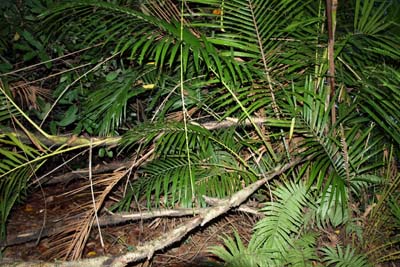Calamus beccarii Information
A clump-forming, tall, water-loving, fast growing, forest understorey, climbing palm. Not known in cultivation, locally common in the wild. It has spiny, brown stems, 50 m. (164 ft.) tall, 4 cm. (1.6 inch) diameter with no obvious leaf scars, and large segmented, pinnate (feather) leaves, 2.1 m. (7 ft.) long, 0.6 m. (2 ft.) wide, green above and beneath. Flagella present Cirri absent.
Calamus beccarii can tolerate close to freezing conditions. But low temperatures are best avoided. This species naturally occurs on islands in moist low montane forest, and is heavily effected by the surrounding sea temperatures, which are constant and often form sea mist and cloud. In this type of natural environment temperature fluctuations are slight, and this palm prefers a constantly mild climate with little temperature difference between day & night, and Summer & Winter. Under extreme cold conditions we recommend you keep this palm as dry as possible, and well wrapped up.
Identification:
Stems clustered, to 50 m long and 4 cm diameter (with leaf sheaths). Leaf sheaths brown, covered with black, needle-like, horizontally spreading spines to 2.5 cm long, these arranged in short rows, interspersed with shorter spines to 0.5 cm long; knees obscure; ocreas present, densely spiny; flagella present, to 2.5 m long, with groups of grapnel-like spines abaxially; petioles to 22 cm long, sparsely covered with stout, yellowish spines to 1 cm long; rachis to 0.8 m long, abaxially with solitary, recurved, grapnel-like spines; pinnae 30-62 per side of rachis, linear, closely spaced to 2 cm apart, to 40 cm long and 1.5 cm wide, with minute spines on the veins abaxially and adaxially; cirri absent. Inflorescences to 3 m long; staminate inflorescences branched to two orders, flagellate, the bracts closely sheathing the main axis and with curved spines abaxially; rachillae 5-9 cm long, inserted above the mouth of the sheathing bract; rachillae bracts distichously arranged; floral bracteole cupular, tomentose along the margins; staminate flowers to 4.5 mm long, to 38 per rachilla, arranged alternately and distichously along the rachillae; calyx 4 mm long, tubular except for the 3-lobed apex; corolla 4 mm long, with 3 valvate petals free to the base; stamens 6; anthers dorsifixed; pistillode 1 mm long, 3-lobed; pistillate inflorescences branched to two orders; rachillae 4-10 cm long; rachillae bracts distichously arranged; distal floral bracteole with a small lateral depression bearing sterile staminate flower; pistillate flowers to 22 per rachilla, borne alternately and distichously along the rachillae; sepals to 4 mm long, connate basally, lobed above; petals to 3 mm long, free; fruits globose-ellipsoid, to 2 cm long including a short beak, to 1.2 cm diameter; scales fringed, yellowish-brown; endosperm homogeneous.
General Information:
A new species of rattan palm from Taiwan. By its climbing habit, flagellum, tubular inflorescence bracts, sessile rachillae, and homogeneous endosperm this species appears to belong in Beccari's (1908) Group V. This large group of species is widespread throughout the Asian tropics. Calamus beccarii appears most similar morphologically to two Group V species from China (C. rhabdocladus Burret and C. walkeri Hance). Calamus beccarii differs from these in its flattened spines) and its larger fruits (to 2 cm versus 1.4 cm long).
Distribution:
Native to, Taiwan
Kaohsiung: Shenping, and Pingtung: Chunjih Hsiang, Chachayalaishan Protection Area, 29th Compartment.
Location: Taiwan (22.765829°N, 120.682755°E)

